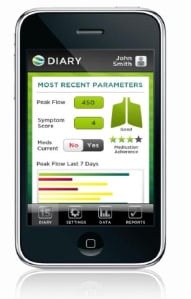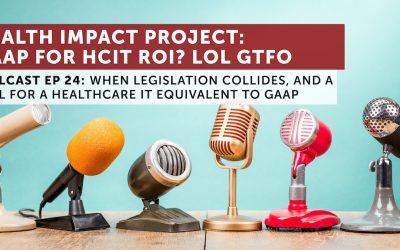
Serious health events such as a severe asthma attack produce such a strong, albeit negative demand for health care that the patient often winds up in the ER. In this respect, asthma is unlike other chronic conditions with more deferred consequences (e.g. ‘diabesity’).
Clay Christensen wrote about this phenomenon in his book, “The Innovator’s Prescription”. Despite the significant behavioral change required (carrying inhalers, taking medication, tracking symptoms, following Asthma Action Plans), asthmatics and their caregivers have good reason to be engaged and compliant with treatment – immediate consequences (relief) to severe attack drive behavioral change (see figure).
A Growing Problem [a Growing Market]
In the US, the CDC reports that 1 in 12 people have asthma. There has also been an unexplained increase in rates among African American children – an almost 50% increase in the past decade.
[Note: Why are asthma rates soaring? Possible causes are not fully understood within the scientific community. The ‘hygiene hypothesis’ blames ultra-clean western societies that suppress the natural development of the immune system. Other research refutes the hygiene hypothesis and points to western lifestyles/obesity as culprits. There have also been more Asthma diagnoses due to improvement in diagnostic methods over the last few decades. Further reading on possible causes can be found at Scientific American.]
Given that asthma is a severe, chronic disease affecting a large percentage of the population, it is easy to make the case for investment in asthma-related products. The American Academy of Allergy Asthma and Immunology (AAAAI) estimates 300 million people worldwide are currently affected – almost 5% of the population, with incidence rates on the rise.
Segmenting the US asthma market by age provides a model to understand key engagement models:
- Asthma Moms are continually engaged in their child’s care. They oftentimes take information, tips, and questions to the blogosphere.
- Adolescents manage their condition with Mom’s guidance, though they are not as vigilant in adhering to treatment plans.
- Adult Asthmatics no longer have Mom looking over their shoulder, but are nonetheless motivated to keep symptoms at bay.
Devices to Monitor & Prevent Asthma Attacks
When my daughter was having frequent wheezing episodes, I would have found piece of mind in a technology that could detect and predict when she was going to have an attack… or at least warn of nearby environmental triggers.
Taking a quick look at the Apple App Store, there are almost 100 asthma-related Apps available. These range from free educational Apps to diary-style Apps that require data entry to track peak flow and symptoms. Do Asthma Moms, especially those whose children have low-severity asthma, really have the time and motivation to write asthma diaries? Not to mention adolescents and adult asthmatics?
One company, iSonea, is building technologies to avoid this tedious (and possibly erroneous) data entry. iSonea is currently making a big bet that consumer and provider appetite for asthma monitoring technologies will grow in the coming years.
iSonea

Note: iSonea was formerly KarmelSonix, a medical device company consisting of a joint partnership between Israel and Australia.
I had the opportunity to speak with the new CEO of iSonea, Michael Thomas, who sees iSonea transitioning from a device-centric company to one that is software-based (guarding the castle with already-acquired IP). In a future filled with Smartphones, iSonea will try to reach those 300 million asthma patients through mobile Apps rather than through proprietary, expensive devices.
Imaging breathing into your Smartphone, which will analyze and quantify your wheezing in the audio. Or, imagine your Smartphone setting off an alarm as it detects nearby environmental triggers, crowd-sourced in almost real time by nearby asthmatics.
iSonea is looking at the following revenue streams:
- App downloads and upgrades. The first version of their AsthmaSense™ App will be released in 2012 with a subscription service.
- Data. Anonymized patient data will be up for sale (iSonea is partnering with Qualcomm Life to get data out of devices and into the cloud). If a statistically significant number of asthmatics use the iSonea App, this data becomes valuable to a host of buyers.
- Ads. Products and services could be marketed to the user based on usage patterns. For example, coupons for therapy drugs could be displayed, etc. (This remains a sensitive area – iSonea needs to find the right amount and types of ads, if any)
Emerging Technologies to Engage Consumers
Another topic I discussed with Mr. Thomas and his VP of Marketing, Michael Cheney, was the issue of how to make the Smartphone App ‘sticky’, or compelling to use. All of us mobile-addicted folks know the feeling – when out of the blue your brain sends you a signal to take your phone out of your pocket and start slinging angry birds.
Will the healthcare space tolerate consumer engagement strategies that have shown success elsewhere? For example, can we social-ify and game-ify healthcare apps and expect higher user engagement? I remain hopeful that, treading carefully, healthcare apps that use social media and gamification strategies can indeed achieve higher engagement rates, especially among digital natives (youths). App developers are already starting to wade into these waters. One interesting example is the DiaPETic App, where users are rewarded via their pet avatar for sticking to a glucose testing plan, much like the popular children’s online game, webkinz.
Who knows, maybe iSonea’s App will indeed spread virally as users encourage their friends to start “playing along” with them as they manage their symptoms and avoid attacks. Engaging adolescents in this manner would especially be appealing to Asthma Moms, who could do with a little less stress in their lives. But iSonea will need to take their existing mHealth App a bit farther than they have to date to enable such viral attraction among adolescents.
Anyone Else Out There?
There is a surprising dearth of competitors to iSonea, which means that either iSonea is particularly early and/or the space is an especially risky one – with no worn paths to tread.
One company that may morph into a company more like iSonea is Asthmapolis.
Asthmapolis is based out of Madison, Wisconsin and founded by Dr David Van Sickle, formerly of the CDC. They manufacture GPS-enabled devices that attach to inhalers, tracking when and where an asthma puff was needed. Recently, Asthmapolis announced a partnership with Dignity Health (formerly Catholic Healthcare West) where doctors will monitor patients’ inhaler use via a mobile App.
Like iSonea, Asthmapolis will make asthma data available to patients and clinicians, and sell it to public health agencies and scientists. Asthmapolis is also developing mobile Apps to receive and display this data, but is not currently (or publicly mentioning) any intent to move beyond GPS-inhalers and towards Smartphone-based asthma monitoring, which is a little surprising in this day and age when just about anyone that is considering a mobile App, typically ahas a smartphone strategy associated with it.
Market Analysis
How will iSonea (and Asthmapolis) defend their strategic positions if the market revs up and new competitors race to the honeypot? Will iSonea’s IP be strong enough? Will they have enough cash to hire good patent infringement lawyers?
Or, maybe this market will really be about the data and network effects. The service to garner the most momentum early on will become exponentially more valuable until the market tips. I wonder if Dr Van Sickle’s relationships with the CDC and medical researchers are strong enough so he has first dibs on selling data for population health management.
It will also be interesting to see when and where pharma will step in here (GlaxoSmithKline comes to mind). Better daily monitoring leads to improved medication compliance, which will help fill pharma coffers. I’m sure iSonea/Asthmapolis are already entertaining numerous solicitations for partnerships from Big Pharma.
Towards the Utopia of ACOs
The improved monitoring and prediction of asthma attacks definitely has a role to play in a post fee-for-service, ACO/PCMH world. No doubt these technologies will help shift the patient’s perceived role from passive recipient of care to a more empowered consumer of health, resulting in less ER visits, less readmissions, and ultimately lowered healthcare costs. The social/crowd sourcing component may prove to be especially valuable – with asthma sufferers steering clear of various dangerous locales where several “attacks” occurred. There is, of course the whole privacy debate and clearly, patients should be given an option as to whether or not they wish to have their data shared. More than likely, most will choose to share their anonymized data, but that should be their choice and not that of the vendor of such solutions.
Of course there is no guarantee that consumers will adopt these technologies en masse. Will this be a technology that consumers ‘pull’ rather than it being pushed on them by providers? Will they adopt without a physician’s order or feedback and without FDA approval? One remaining issue is how to monitor children who can’t be trusted to carry a smartphone – either they need to wear some form of (expensive) proprietary device or then again mobile platforms such as the Apple iTouch with a simple data plan may fill this gap.
On a personal level, I would nevertheless like to see asthma monitoring stand out as a poster child for remote monitoring success. If we can figure out a way to engage Asthma Moms, adolescents (with Social/Gamification strategies), and adult sufferers, then moving on to other chronic conditions on Dr. Christenson’s 2×2 matrix will begin to look more achievable.
Just this morning my daughter told me that she had trouble breathing last night. I look forward to the day when instead of me learning of her symptoms after-the-fact, a phone can wake me up in the middle of the night to warn me to check on her immediately.





Mediclim http://www.mediclim.com issues free medical alerts to subscribers when weather patterns are predicted in any location that are likely to impact upon certain illness classes – Asthma, diabetes, migraine, heart disease, arthritis and COPD.
Subscribers can currently log onto the Mediclim website and register their illness. The Mediclim system then computes on a daily basis, the risk of aggravation of any of these six diseases.
Mediclim then issues an alert via e-mail to the subscriber if a weather system is predicted in their area which is likely to exacerbate their specific illness condition.
How about activity in the Diabetes iPhone space, seems like a logical direction? Is there a dearth of activity there as well?
Tim – lots of activity in the Diabetes management mobile app space, from the FDA-cleared Welldoc to various different types of apps that enable users to log glucose readings, diet, exercise, or deliver encouragement to make good food choices.
Cora,
We’re pursuing the use of Health Impact Bonds to raise capital for “upstream” health interventions (prevention) that reduce “downstream” costs. Bond investors who finance the interventions are repaid principal + interest based on a share of medical cost saved by insurers, ACOs, etc.
We think there’s a big opportunity for this kind of financing in asthma management, since (sadly) there are far too many cases of unmanaged asthma. So, for example, if iSonea or Asthmapolis can achieve validated cost savings by bringing down ER and hospitalizations, then we might get impact investors to provide the upfront capital for the intervention.
A paper on Health Impact Bonds co-written by Collective Health and UC Berkeley is linked here: http://wp.me/p1rpo0-Z.
We’d love to hear ideas on this… For example, what are the evidence-based interventions proven to reduce health care utilization (within a reasonable timeframe…1-5 years) for asthma, diabetes, heart disease, and other chronic/acute illnesses?
Rick
Rick, that is the billion (trillion?) dollar question. Right now the most forward-thinking payors are experimenting with various consumer technologies (social media, apps, games, …) to engage their members and keep them out of the hospital. I’ll be writing more and more about the effecacy of these interventions…
Bronchial asthma is usually a continual the respiratory system problem and it is quite common in just concerning all the parts around the globe. Sometimes you will discover signs or symptoms that will look like allergies but don’t truly qualify to get the whole broken illness. This kind of enhances the need for comprehending Symptoms of asthma fully being an ailment in order that correct elimination along with remedy may then be performed.’
Look at our own web-site too
<'http://www.foodsupplementdigest.com/high-potassium-foods/